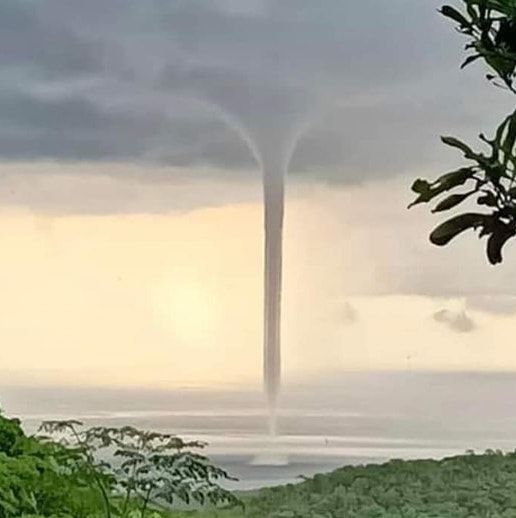
Waterspouts are an awe-inspiring atmospheric phenomenon formed as a result of complex atmospheric conditions.

Tornadic waterspout off the coast of Punta Gorda, Florida, caused by a severe thunderstorm. Image credit: Punta Gorda Police Department
In their most common form, waterspouts are essentially tornadoes that form over water. They can occur in both saltwater and freshwater environments and are most common in areas where warm and cool air masses meet, such as in the tropics or during stormy weather. When a thunderstorm or heavy rain shower passes over a body of water, it can create conditions that are conducive to waterspout formation.
There are two main types of waterspouts: tornadic and fair-weather. Tornadic waterspouts are the more powerful of the two and are associated with thunderstorms that can have wind speeds of up to 100 miles per hour or more. Fair-weather waterspouts, on the other hand, are much weaker and typically form on clear, calm days. They are usually much smaller and shorter-lived than tornadic waterspouts.


A waterspout is not filled with water from the ocean or lake above which it appears. Rather, the water inside it is formed through condensation within the cloud. Image credit: Umberto Salvagnin
Waterspouts can form when winds blowing in two different directions run into each other. This junction, also known as a “convergence line” or “shear line,” generates a significant amount of rotational air near the surface. The meeting of the two winds results in an upward movement of air as there is no other direction for it to go. The upward moving air transports water vapor high into the sky, creating showers and cumulus clouds. As the air ascends, it can alter the horizontal rotation of air close to the surface and cause it to shift into the vertical direction. When this vertical spin consolidates in a particular spot, it begins to draw up water, resulting in a waterspout.
Contrary to its name, a waterspout is not filled with water from the ocean or lake above which it appears. Rather, the water inside it is formed through condensation within the cloud.
Since watersprouts tend to form along the intersection of two divergent winds, it is common to observe a sequence of waterspouts in a straight line. In such cases, spinning low-level air is pulled upwards at various points.

A line of watersprouts over the Gulf of Mexico, photographed near Biloxi, Mississippi. Image credit: Michael Fontaine
Waterspouts can form just anywhere in the world’s coastal regions, without any specific location being more prone to their occurrence. That said, certain regions experience waterspouts more frequently than others. The Florida Keys, Cienfuegos Bay in Cuba, and the Great Lakes are among the places where waterspouts have been most commonly observed.
Occasionally, a winter waterspout, also referred to as an icespout, ice devil, or snowspout, can form beneath the base of a snow squall. This type of waterspout is a unique occurrence and is distinguished from the more common warm-season waterspout. For a snowsprout to form, two critical conditions must be met. Firstly, the body of water beneath it must be warm enough to generate fog that appears like steam in frigid temperatures. Secondly, winds focused down the axis of lengthy lakes enhance wind convergence and likely play a role in their development.
Trong khi vòi rồng có thể hấp dẫn để xem, chúng cũng có thể nguy hiểm. Đặc biệt, vòi rồng lốc xoáy có thể gây thiệt hại đáng kể cho tàu thuyền, tòa nhà và các công trình kiến trúc khác. Chúng cũng có thể gây nguy hiểm cho những người bơi lội và những người khác đang ở trong hoặc gần nước. Vì vậy, nếu bạn muốn quan sát vẻ đẹp và sức mạnh của những hiện tượng đáng kinh ngạc này trong đời thực đồng thời giảm thiểu những rủi ro do chúng gây ra, thì bạn luôn nên cập nhật thông tin và lưu ý về điều kiện thời tiết địa phương.
Nguồn: special68.com





